A Fuzzy Method for Solving Fuzzy Fractional Differential Equations Based on the Generalized Fuzzy Taylor Expansion
Abstract
1. Introduction
2. Basic Concepts
- I.
- u is normal: there exists an such that .
- II.
- u is fuzzy convex: for .
- III.
- u is upper semi-continuous: for any , it holds that .
- IV.
- is a compact subset.
- I.
- II.
- III.
- I.
- The function f is -differentiable at if .
- II.
- The function f is -differentiable at if
3. Definitions and Properties of Fractional -Differentiability
- (type I)
- f is -differentiable at while f is not -differentiable at , andf is -differentiable at while f is not -differentiable ator
- (type II)
- f is -differentiable at while f is not -differentiable atand f is -differentiable at while f is not -differentiable at
- I.
- If is -differentiable then is -integrable over and
- II.
- If is -differentiable then is -integrable over and
- I.
- Let be the -differentiable, and they do not change in the type of differentiability on then
- II.
- If are -differentiable and the type of their differentiability does not change in the interval then
- III.
- Assume that are the -differentiable and they are -differentiable, for then
- IV.
- Suppose that are -differentiable and they are -differentiable for , so
- II.
- Our proof starts with the observation that are -differentiable. Therefore, using the properties of fuzzy Caputo derivative and Theorem 2, we havethus, we obtain
- III.
- Under the conditions stated in the part III, is -differentiable for and it is -differentiable for . In the sense of Section 2 and by Theorem 2, we getwhich completes the proof. □
4. Fuzzy Generalized Taylor Theorem
- I.
- If are -differentiable, provided that type of fuzzy Caputo differentiability has no change. Then,where
- II.
- If are -differentiable, provided that type of fuzzy Caputo differentiability has no change, thenwhere
- III.
- If exist and in each order the type of -differentiability changes on Twhere
- IV.
- For , suppose that f on is -differentiable and on is -differentiable, in fact ξ is switching point (type II) for α-order derivative of f. Moreover, for , let -order derivative of f in of have switching point (type I). On the other hand, the type of differentiability for on does not change. Therefore,
- II.
- As f is a continuous function and -differentiable, by Theorem 2, we getUnder the hypotheses of Theorem, type of differentiability does not change, so by Theorem 3 and by attention to -integrability of on T, we obtainApplying operator to , givesLemma 2 implies that the last double -fractional integral belongs to . Therefore,by repeating the above argument, we getTherefore, we find thatmoreoverBy Lemma 2, the last triple -fractional integral belongs to . Therefore, substituting above equation into Equation (4), we find thatthe high order of the last formula by Lemma 2 is a continuous function in terms of t so it belongs to . With the same manner, we can demonstrate that part is satisfied.
- III.
- Suppose that f is -differentiable. Using Theorem 2, we haveUnder the hypothesis of theorem, as f is -differentiable, is -differentiable. Therefore, by Theorem 3 we getNow, applying operator -integral to givesLemma 2 now leads to the last double (F.RL)-fractional integral belongs to . Therefore,Similarly, as is -differentiable, is -differentiable and we getthusNow, applying operator givesas this satisfies all the other conditions for the Lemma 2, the last triple -fractional integral belongs to . Then,with simple and similar method, the proof for this type of differentiability will be completed.
- IV.
- As f is -differentiable in , Theorem 2 leads toand in the interval , f is -differentiable, so forAccording to the hypothesis, we know that is a switching point for differentiability f; thus, by substituting Equation (5) into Equation (6), we obtainConsider the first -fractional integral on the right side of the Equation (7):By noting the hypothesis of theorem, the fuzzy Caputo derivative of the function f has the switching point of type I. Therefore, is -differentiable on , then type of differentiability can be changed. By these conditions, the Theorem 3, admits thatOn the other hand, we know that is -differentiable on and the type of differentiability does not change. Thus, for from Theorem 3, it follows thatsubstituting Equation (8) into Equation (9) givesthatfollows from Theorem 3 and alsothe insertion of Equations (11) and (12) in Equation (10) allows us to obtainFinally, the first -fractional integral on the right side of the Equation (7) obtains as followsthe only point remaining concerns the behavior of the second -fractional integral on the right side of the Equation (7). We can now proceed analogously to the first -fractional integral:By noting the hypothesis of theorem, are -differentiable on , and the type of differentiability does not change. By Theorem 3 we deduce thatandsubstituting (15) into (14) we obtainThus, the second -fractional integral on the right side of the Equation (7) is as follows,having disposed of this preliminary step, we can now return to the Equation (7).By substituting Equations (13) and (16), in Equation (7), the desired result is achieved. □
5. Fuzzy Generalized Euler’s Method
6. Analysis of the Fuzzy Generalized Euler’s Method
6.1. Local Truncation Error, Consistent
6.2. Global Truncation Error, Convergence
6.3. Stability
7. Numerical Simulations
8. Conclusions
Author Contributions
Funding
Acknowledgments
Conflicts of Interest
References
- Agarwal, R.P.; Lakshmikantham, V.; Nieto, J.J. On the concept of solution for fractional differential equations with uncertainty. Nonlinear Anal. Theory Methods Appl. 2010, 72, 2859–2862. [Google Scholar] [CrossRef]
- Bhaskara, T.G.; Lakshmikanthama, V.; Leela, S. Fractional differential equations with a krasnoselskii-krein type condition. Nonlinear Anal. Hybrid Syst. 2009, 3, 734–737. [Google Scholar] [CrossRef]
- Kilbas, A.A.; Srivastava, M.H.; Trujillo, J.J. Theory and Application of Fractional Differential Equations; Elsevier: Amsterdam, The Netherlands, 2006; Volume 204, ISBN-13 978-0-444-51832-3. [Google Scholar]
- Miller, K.S.; Ross, B. An Introduction to the Fractional Calculus and Fractional Diffrential Equations; John Wiley and Sons: New York, NY, USA, 1993. [Google Scholar]
- Noeiaghdam, Z.; Allahviranloo, T.; Nieto, J.J. q-fractional differential equations with uncertainty. Soft Comput. 2019, 23, 9507–9524. [Google Scholar] [CrossRef]
- Ngo, V.H. Fuzzy fractional functional integral and differential equations. Fuzzy Sets Syst. 2015, 280, 58–90. [Google Scholar] [CrossRef]
- Allahviranloo, T. Uncertain Information and Linear Systems. In Studies in Systems, Decision and Control; Springer: Berlin/Heidelberg, Germany, 2020; Volume 254, pp. 109–119. ISBN 978-3-030-31323-4. [Google Scholar]
- Allahviranloo, T.; Gouyandeh, Z.; Armand, A. A full fuzzy method for solving differential equation based on Taylor expansion. J. Intell. Fuzzy Syst. 2015, 29, 1039–1055. [Google Scholar] [CrossRef]
- Chehlabi, M.; Allahviranloo, T. Concreted solutions to fuzzy linear fractional differential equations. Appl. Soft Comput. 2016, 44, 108–116. [Google Scholar] [CrossRef]
- Hoa, N.V. Fuzzy fractional functional differential equations under Caputo gH-differentiability. Commun. Nonlinear Sci. And Numerical Simul. 2015, 22, 1134–1157. [Google Scholar] [CrossRef]
- Agarwal, R.P.; Baleanu, D.; Nieto, J.J.; Torres, D.F.M.; Zhou, Y. A survey on fuzzy fractional differential and optimal control nonlocal evolution equations. J. Comput. Appl. Math. 2018, 339, 3–29. [Google Scholar] [CrossRef]
- Long, H.V.; Son, N.T.K.; Tam, H.T.T. The solvability of fuzzy fractional partial differential equations under Caputo gH-differentiability. Fuzzy Sets Syst. 2017, 309, 35–63. [Google Scholar] [CrossRef]
- Salahshour, S.; Allahviranloo, T.; Abbasbandy, S. Solving fuzzy fractional differential equations by fuzzy Laplace transforms. Commun. Nonlinear Sci. Numer. Simul. 2012, 17, 1372–1381. [Google Scholar] [CrossRef]
- Khodadadi, E.; Celik, E. The Variational Iteration Method For Fuzzy Fractional Differential Equations With Uncertainty. Fixed Point Theory Appl. 2013, 2013, 1–13. [Google Scholar] [CrossRef][Green Version]
- Mazandarani, M.; Kamyad, A.V. Modified fractional Euler method for solving Fuzzy Fractional Initial Value Problem. Commun. Nonlinear Sci. Numer. Simulat. 2013, 18, 12–21. [Google Scholar] [CrossRef]
- Ahmadian, A.; Suleiman, M.; Salahshour, S.; Baleanu, D. A Jacobi Operational Matrix for Solving A Fuzzy Linear Fractional Differential Equation. Adv. Differ. Equations 2013, 2013, 1–29. [Google Scholar] [CrossRef]
- Masjed-Jamei, M.; Moalemi, Z.; Area, I.; Nieto, J.J. A new type of Taylor series expansion. J. Inequalities Appl. 2018, 116. [Google Scholar] [CrossRef]
- Noeiaghdam, S.; Sidorov, D.; Sizikov, V.; Sidorov, N. Control of accuracy on Taylor-collocation method to solve the weakly regular Volterra integral equations of the first kind by using the CESTAC method. Appl. Comput. Math. 2020, 19, 87–105. [Google Scholar]
- Zarei, E.; Noeiaghdam, S. Solving generalized Abel’s integral equations of the first and second kinds via Taylor-collocation method. arXiv 2018, arXiv:1804.08571. [Google Scholar]
- Allahviranloo, T.; Chehlabi, M. Solving fuzzy differential equations based on the length function properties. Soft Comput. 2015, 19, 307–320. [Google Scholar] [CrossRef]
- Allahviranloo, T.; Abbasbandy, S.; Sedaghgatfar, O.; Darabi, P. A new method for solving fuzzy integro-differential equation under generalized differentiability. Neural Comput. Appl. 2012, 21, 191–196. [Google Scholar] [CrossRef]
- Bede, B.; Stefanini, L. Generalized differentiability of fuzzy-valued functions. Fuzzy Set Syst. 2013, 230, 119–141. [Google Scholar] [CrossRef]
- Goetschel, R.; Voxman, W. Elementary fuzzy calculus. Fuzzy Sets Syst. 1987, 24, 31–43. [Google Scholar] [CrossRef]
- Ma, M.; Friedman, M.; Kandel, A. A new fuzzy arithmetic. Fuzzy Set. Syst. 1999, 108, 83–90. [Google Scholar] [CrossRef]
- Stefanini, L.; Bede, B. Generalized Hukuhara differentiability of interval-valued functions and interval differential equations. Nonlinear Anal. 2009, 71, 1311–1328. [Google Scholar] [CrossRef]
- Chakraverty, S.; Tapaswini, S.; Behera, D. Fuzzy Arbitrary Order System: Fuzzy Fractional Differential Equations and Applications; Wiley: Hoboken, NJ, USA, 2016. [Google Scholar]
- Anastassiou, G.A. Fuzzy mathematics: Approximation theory. Stud. Fuzziness Soft Comput. 2010, 251, 267–271. [Google Scholar]
- Epperson, J.F. An Introduction to Numerical Methods and Analysis; John Wiley and Sons: Hoboken, NJ, USA, 2007. [Google Scholar]
- Gear, C.W. Numerical Initial Value Problems in Ordinary Differential Equations; Prentice Hall: Englewood Clifs, NJ, USA, 1971. [Google Scholar]
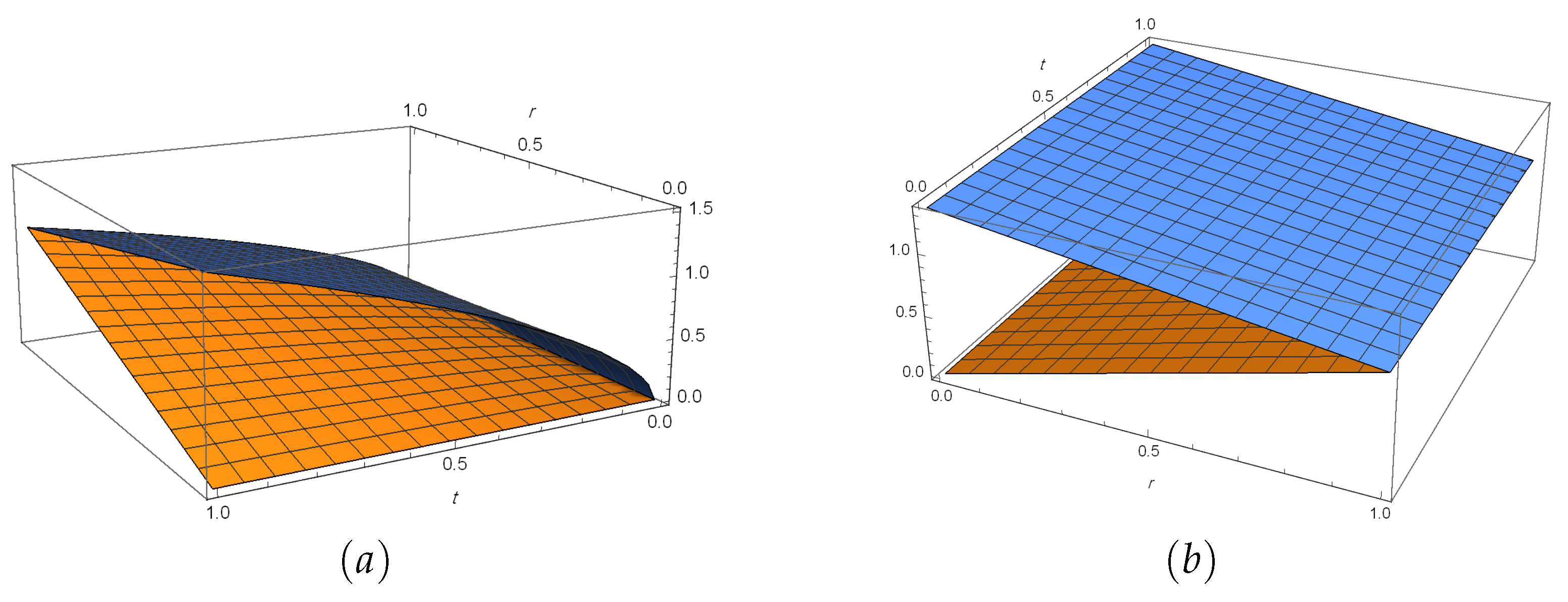
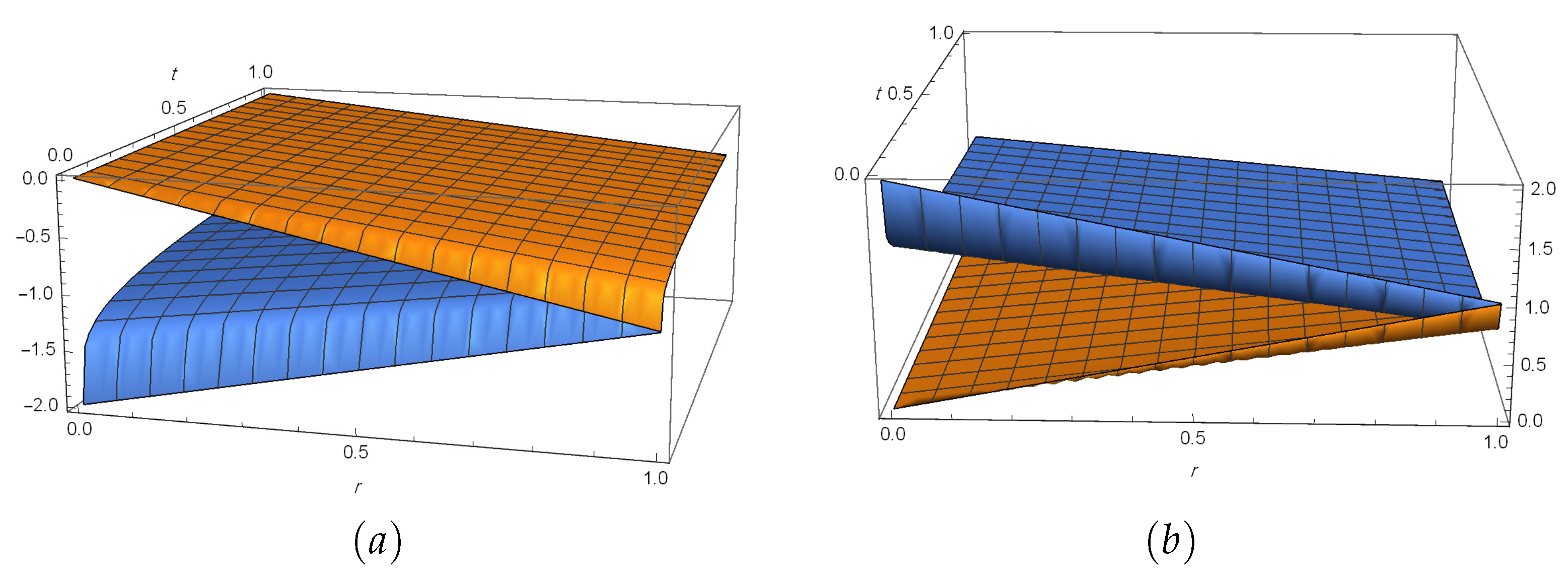
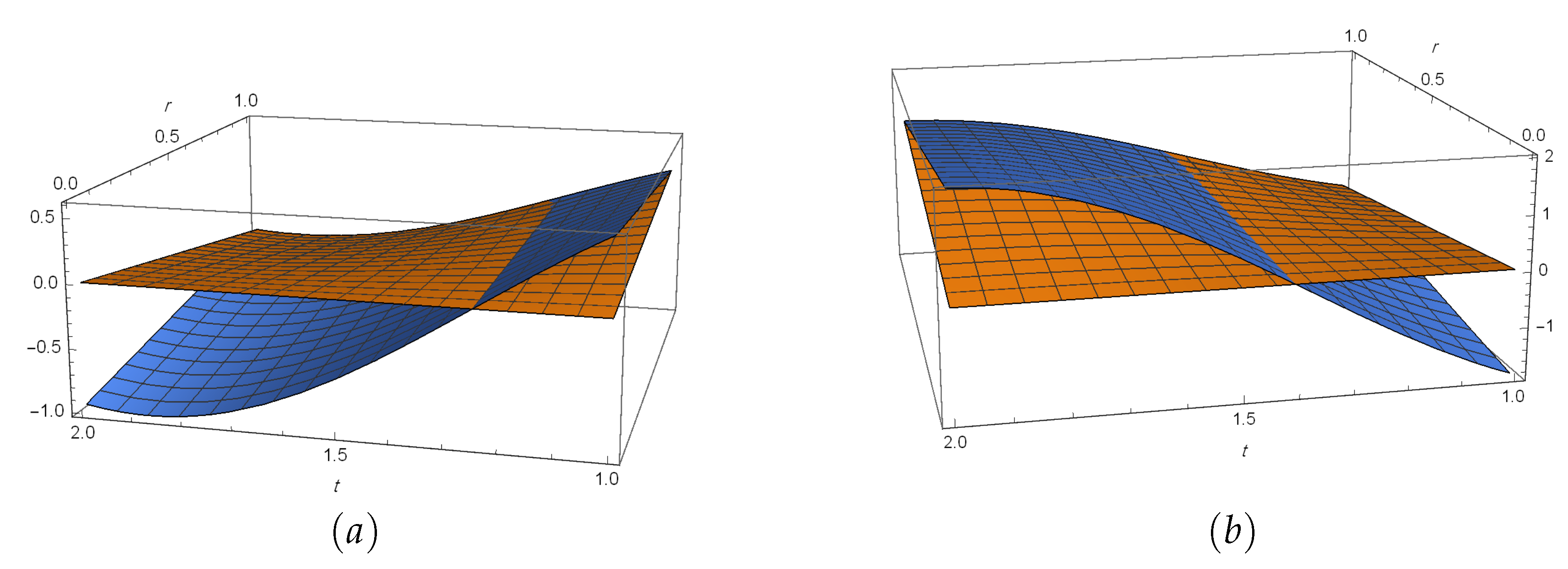
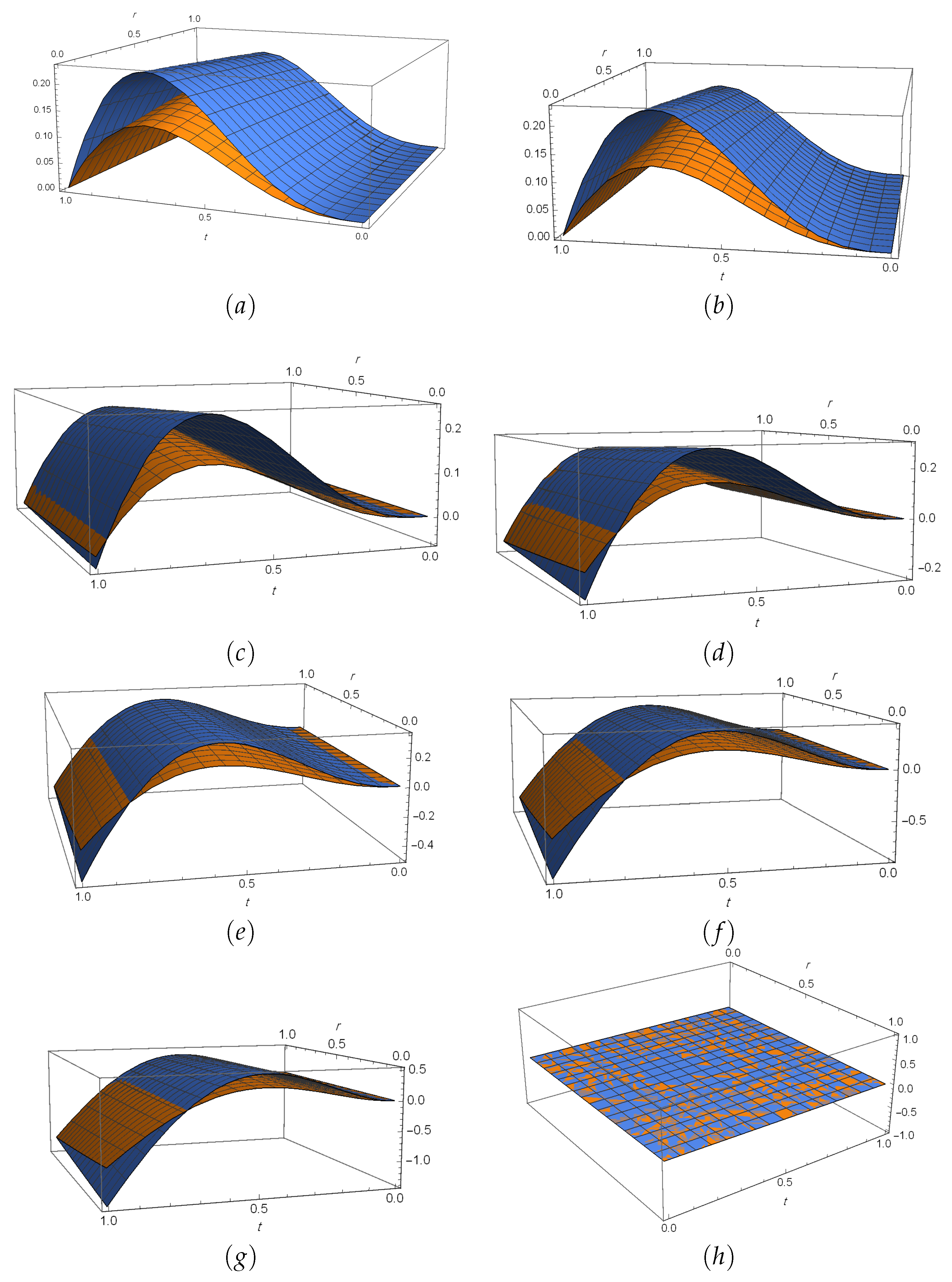
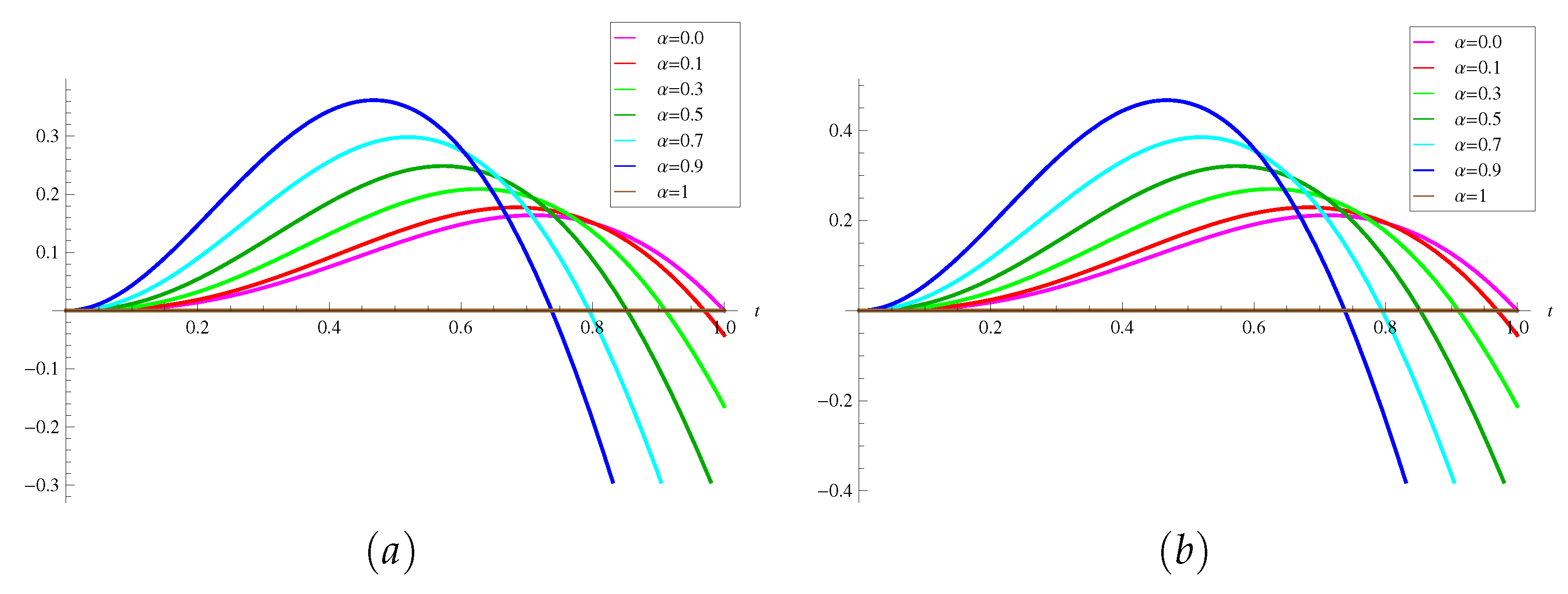
| 0.1 | (0, 0.617034, 0.925551) | (0, 0.309249, 0.463874) | (0, 0.380731, 0.571096) | (0, 0.0956352, 0.143453) | (0, 0.234924, 0.352386) | (0, 0.0295752, 0.0443627) |
| 0.2 | (0, 1.23407, 1.8511) | (0, 0.618499, 0.927748) | (0, 0.761462, 1.14219) | (0, 0.19127, 0.286906) | (0, 0.469848, 0.704771) | (0, 0.0591503, 0.0887255) |
| 0.3 | (0, 1.8511, 2.77665) | (0, 0.927748, 1.39162) | (0, 1.14219, 1.71329) | (0, 0.286906, 0.430359) | (0, 0.704771, 1.05716) | (0, 0.0887255, 0.133088) |
| 0.4 | (0, 2.46814, 3.7022) | (0, 1.237, 1.8555) | (0, 1.52292, 2.28438) | (0, 0.382541, 0.573811) | (0, 0.939695, 1.40954) | (0, 0.118301, 0.177451) |
| 0.5 | (0, 3.08517, 4.62775) | (0, 1.54625, 2.31937) | (0, 1.90365, 2.85548) | (0, 0.478176, 0.717264) | (0, 1.17462, 1.76193) | (0, 0.147876, 0.221814) |
| 0.6 | (0, 3.7022, 5.5533) | (0, 1.8555, 2.78325) | (0, 2.28438, 3.42658) | (0, 0.573811, 0.860717) | (0, 1.40954, 2.11431) | (0, 0.177451, 0.266176) |
| 0.7 | (0, 4.31924, 6.47886) | (0, 2.16475, 3.24712) | (0, 2.66512, 3.99767) | (0, 0.669447, 1.00417) | (0, 1.64447, 2.4667) | (0, 0.207026, 0.310539) |
| 0.8 | (0, 4.93627, 7.40441) | (0, 2.474, 3.71099) | (0, 3.04585, 4.56877) | (0, 0.765082, 1.14762) | (0, 1.87939, 2.81909) | (0, 0.236601, 0.354902) |
| 0.9 | (0, 5.5533, 8.32996) | (0, 2.78325, 4.17487) | (0, 3.42658, 5.13987) | (0, 0.860717, 1.29108) | (0, 2.11431, 3.17147) | (0, 0.266176, 0.399265) |
| 1.0 | (0, 6.17034, 9.25551) | (0, 3.09249, 4.63874) | (0, 3.80731, 5.71096) | (0, 0.956352, 1.43453) | (0, 2.34924, 3.52386) | (0, 0.295752, 0.443627) |
| 0.1 | (0, 0.312475, 0.624949) | (0, 0.655421, 1.31084) | (0, 0.573896, 1.14779) | (0, 0.892967, 1.78593) | (0, 0.755737, 1.51147) | (0, 0.969249, 1.9385) |
| 0.2 | (0, 0.0976404, 0.195281) | (0, 0.429577, 0.859154) | (0, 0.329356, 0.658712) | (0, 0.797391, 1.59478) | (0, 0.571138, 1.14228) | (0, 0.939444, 1.87889) |
| 0.3 | (0, 0.0305101, 0.0610203) | (0, 0.281554, 0.563107) | (0, 0.189016, 0.378032) | (0, 0.712044, 1.42409) | (0, 0.43163, 0.863261) | (0, 0.910555, 1.82111) |
| 0.4 | (0, 0.00953365, 0.0190673) | (0, 0.184536, 0.369072) | (0, 0.108476, 0.216951) | (0, 0.635832, 1.27166) | (0, 0.326199, 0.652398) | (0, 0.882555, 1.76511) |
| 0.5 | (0, 0.00297902, 0.00595805) | (0, 0.120949, 0.241898) | (0, 0.0622536, 0.124507) | (0, 0.567777, 1.13555) | (0, 0.246521, 0.493042) | (0, 0.855415, 1.71083) |
| 0.6 | (0, 0.000930869, 0.00186174) | (0, 0.0792725, 0.158545) | (0, 0.0357271, 0.0714542) | (0, 0.507007, 1.01401) | (0, 0.186305, 0.37261) | (0, 0.829111, 1.65822) |
| 0.7 | (0, 0.000290873, 0.000581746) | (0, 0.0519568, 0.103914) | (0, 0.0205036, 0.0410072) | (0, 0.45274, 0.905481) | (0, 0.140797, 0.281595) | (0, 0.803615, 1.60723) |
| 0.8 | (0, 0.0000908904, 0.000181781) | (0, 0.0340536, 0.0681072) | (0, 0.0117669, 0.0235339) | (0, 0.404282, 0.808565) | (0, 0.106406, 0.212812) | (0, 0.778903, 1.55781) |
| 0.9 | (0, 0.000028401, 0.0000568019) | (0, 0.0223195, 0.0446389) | (0, 0.00675299, 0.013506) | (0, 0.361011, 0.722022) | (0, 0.0804149, 0.16083) | (0, 0.754951, 1.5099) |
| 1.0 | (0,,0.0000177492) | (0, 0.0146286, 0.0292573) | (0, 0.00387551, 0.00775103) | (0, 0.322371, 0.644742) | (0, 0.0607725, 0.121545) | (0, 0.731735, 1.46347) |
| 1.1 | (0, −0.452376, −0.918699) | (0, −0.463549, −0.928996) | (0, −0.464888, −0.929776) |
| 1.2 | (0, −0.489654, −0.984721) | (0, −0.495423, −0.991934) | (0, −0.496057, −0.992115) |
| 1.3 | (0, −0.489654, −0.984721) | (0, −0.495423, −0.991934) | (0, −0.496057, −0.992115) |
| 1.4 | (0, −0.452376, −0.918699) | (0, −0.463549, −0.928996) | (0, −0.464888, −0.929776) |
| 1.5 | (0, −0.400112, −0.800241) | (0, −0.404397, −0.808832) | (0, −0.404508, −0.809017) |
| 1.6 | (0, −0.307754, −0.628932) | (0, −0.317689, −0.637143) | (0, −0.318712, −0.637424) |
| 1.7 | (0, −0.20878, −0.417784) | (0, −0.21233, −0.425584) | (0, −0.21289, −0.425779) |
| 1.8 | (0, −0.0927856, −0.176232) | (0, −0.0935876, −0.187196) | (0, −0.0936907, −0.187381) |
| 1.9 | (0, 0.0304523, 0.0618529) | (0, 0.0313271, 0.0627734) | (0, 0.0313953, 0.0627905) |
| 2.0 | (0, 0.146488, 0.301241) | (0, 0.15359, 0.308805) | (0, 0.154508, 0.309017) |
| h | |||||
|---|---|---|---|---|---|
| 1 | ||||||
| t |
Publisher’s Note: MDPI stays neutral with regard to jurisdictional claims in published maps and institutional affiliations. |
© 2020 by the authors. Licensee MDPI, Basel, Switzerland. This article is an open access article distributed under the terms and conditions of the Creative Commons Attribution (CC BY) license (http://creativecommons.org/licenses/by/4.0/).
Share and Cite
Allahviranloo, T.; Noeiaghdam, Z.; Noeiaghdam, S.; Nieto, J.J. A Fuzzy Method for Solving Fuzzy Fractional Differential Equations Based on the Generalized Fuzzy Taylor Expansion. Mathematics 2020, 8, 2166. https://doi.org/10.3390/math8122166
Allahviranloo T, Noeiaghdam Z, Noeiaghdam S, Nieto JJ. A Fuzzy Method for Solving Fuzzy Fractional Differential Equations Based on the Generalized Fuzzy Taylor Expansion. Mathematics. 2020; 8(12):2166. https://doi.org/10.3390/math8122166
Chicago/Turabian StyleAllahviranloo, Tofigh, Zahra Noeiaghdam, Samad Noeiaghdam, and Juan J. Nieto. 2020. "A Fuzzy Method for Solving Fuzzy Fractional Differential Equations Based on the Generalized Fuzzy Taylor Expansion" Mathematics 8, no. 12: 2166. https://doi.org/10.3390/math8122166
APA StyleAllahviranloo, T., Noeiaghdam, Z., Noeiaghdam, S., & Nieto, J. J. (2020). A Fuzzy Method for Solving Fuzzy Fractional Differential Equations Based on the Generalized Fuzzy Taylor Expansion. Mathematics, 8(12), 2166. https://doi.org/10.3390/math8122166







